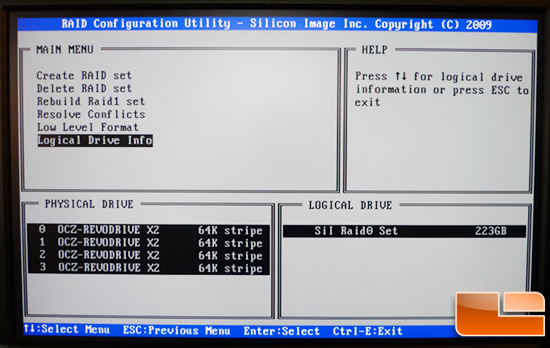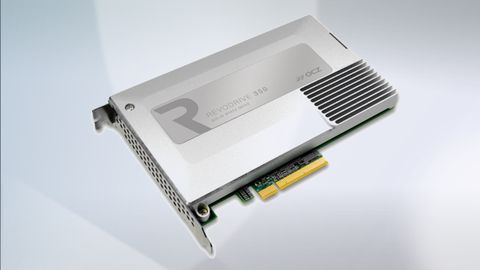

The RAID controller and VCA 2.0
In theory, OCZ's approach wouldn't require matching stripe size to workload - all you need is tons of parallel IO and the software/firmware should.
The two SandForce controllers on the RevoDrive 3 and the four SandForce controllers for the X2 model point towards an OCZ raid controller. In the past OCZ made use of an LSI controller, but there was no way to get TRIM commands to the data, which sucked. That changes with the RevoDrive series 3. Very little is know about the new RAID controller but it is proprietary to OCZ and it is their own IC (see below), sitting on top of the RAID controller is a virtualized software layer injecting some options that previously where unavailable, this is called VCA.
Virtualized Controller Architecture 2.0 is a new flash virtualization layer. This is the follow up on to the original VCA and is presented as a complete storage subsystem, but with an improved and expanded feature-set. VCA Technology enables TRIM and enhances enterprise features to include SMART monitoring, NCQ, TCQ, power failure management as well as wear-leveling in the Revo 3 and Z Drive series.
So yeah, you read that right -- TRIM is now enabled slash possible in this RAID 0 product.
Here's (courtesty to OCZ) on that:
Utilizes OCZ proprietary VCA 2.0 (Virtualized Controller Architecture) which provides features including TRIM and SMART data monitoring. This follow up to VCA, presents as a complete storage subsystem, but with an improved and expanded feature-set allowing users unprecedented flexibility and industry-leading performance and reliability.
VCA 2.0 also provides a highly intelligent Complex Command Queuing Structure (CCQS) that utilizes both Native and Tagged Command Queuing. This is a unique technology that enables command switching and balancing based on OCZs proprietary Queue Balancing Algorithm (QBA), which balances drive loading, while maximizing internal bandwidth for nearly linear performance aggregation.
Enterprise Features
- OCZ SuperScale storage controller enables infinitely scalable performance.
- VCA 2.0 in OCZ enterprise PCIe devices supports the creation of a virtual pool of logical units (LUNs) and features best-in-class configurable performance aggregation.
- VCA 2.0 is the only virtualization layer in the industry with TRIM and SCSI Unmap Support to enhance sustained performance by significantly reducing the overhead associated with garbage collection.
- Consolidated SMART support provides system administrators with advanced features for
monitoring, analyzing and reporting device attributes. - User-selectable data recovery and non-stop modes allow for unprecedented data protection.
Unlike other flash virtualization layers, OCZ VCA 2.0 supports complete power fail protection; OCZ enterprise PCIe devices store all metadata in nonvolatile memory while power fail protection completes all in-progress transactions in the event of an unexpected system power loss.
OCZ SuperScale storage accelerator for scalable performance
The OCZ SuperScale storage controller combines processing and full DMA (direct memory access) cores, as well as internal PCIe, SATA and SAS interfaces. This controller, combined with VCA 2.0 provides unique benefits to users by allowing certain DMA and data management functions including OCZs unique command queuing and queue balance algorithms to be handled by the onboard processing core, resulting in higher performance and reduced burden on the host CPU. OCZ is currently offering single slot PCIe solutions with up to 2 SuperScale accelerators per slot as standard parts.
New LUN Addressing with VCA 2.0 in OCZ Enterprise PCIe Devices
In the enterprise PCIe implementation of VCA 2.0, users have the option of treating each
SuperScale accelerator as one more Virtual Logical Drive (LUNs). Storage management software
such as file systems, volume managers, and applications are able to access a number of LUNs
allowing unprecedented flexibility in storage, while maintaining the hardware assisted features of
VCA 2.0 and enabling the host to boot from the PCIe device.
User Friendly -SCSI Over PCIe Functionality Allows Seamless Installation
OCZ VCA 2.0 supports the industry standard SCSI command set over our PCIe interface. Because SCSI is the command set of choice of enterprise storage architects, this feature makes installation of OCZ PCIe devices in enterprise applications seamless.
VCA technology can interpret and execute both SCSI and ATA commands across any physical interface and utilize any available internal interface to facilitate communication across multiple elements of the overall drive architecture. Current OCZ hardware implementations support SCSI commands over PCIe (Z-Drive) and Serial (Talos). This storage virtualization currently allows SCSI commands to be sent through PCIe or SAS physical interfaces to an internal virtualized array of NAND devices.

Configurable Performance Aggregation
VCA provides highly efficient performance aggregation across physical LUNs via an intelligent complex command queuing structure that utilizes both native and tagged command queuing (NCQ, TCQ). This is a unique technology that enables command switching and balancing based on OCZs proprietary Queue Balancing Algorithm (QBA) algorithm; this balances drive loading while maximizing internal bandwidth for nearly linear performance aggregation. VCA 2.0 LUNs can be further aggregated through cascading with host-side striping, dependant on the storage architects needs.
- Author: admin
- Category: Category

The RAID controller and VCA 2.0
In theory, OCZ's approach wouldn't require matching stripe size to workload - all you need is tons of parallel IO and the software/firmware should.
The two SandForce controllers on the RevoDrive 3 and the four SandForce controllers for the X2 model point towards an OCZ raid controller. In the past OCZ made use of an LSI controller, but there was no way to get TRIM commands to the data, which sucked. That changes with the RevoDrive series 3. Very little is know about the new RAID controller but it is proprietary to OCZ and it is their own IC (see below), sitting on top of the RAID controller is a virtualized software layer injecting some options that previously where unavailable, this is called VCA.
Virtualized Controller Architecture 2.0 is a new flash virtualization layer. This is the follow up on to the original VCA and is presented as a complete storage subsystem, but with an improved and expanded feature-set. VCA Technology enables TRIM and enhances enterprise features to include SMART monitoring, NCQ, TCQ, power failure management as well as wear-leveling in the Revo 3 and Z Drive series.
So yeah, you read that right -- TRIM is now enabled slash possible in this RAID 0 product.
Here's (courtesty to OCZ) on that:
Utilizes OCZ proprietary VCA 2.0 (Virtualized Controller Architecture) which provides features including TRIM and SMART data monitoring. This follow up to VCA, presents as a complete storage subsystem, but with an improved and expanded feature-set allowing users unprecedented flexibility and industry-leading performance and reliability.
VCA 2.0 also provides a highly intelligent Complex Command Queuing Structure (CCQS) that utilizes both Native and Tagged Command Queuing. This is a unique technology that enables command switching and balancing based on OCZs proprietary Queue Balancing Algorithm (QBA), which balances drive loading, while maximizing internal bandwidth for nearly linear performance aggregation.
Enterprise Features
- OCZ SuperScale storage controller enables infinitely scalable performance.
- VCA 2.0 in OCZ enterprise PCIe devices supports the creation of a virtual pool of logical units (LUNs) and features best-in-class configurable performance aggregation.
- VCA 2.0 is the only virtualization layer in the industry with TRIM and SCSI Unmap Support to enhance sustained performance by significantly reducing the overhead associated with garbage collection.
- Consolidated SMART support provides system administrators with advanced features for
monitoring, analyzing and reporting device attributes. - User-selectable data recovery and non-stop modes allow for unprecedented data protection.
Unlike other flash virtualization layers, OCZ VCA 2.0 supports complete power fail protection; OCZ enterprise PCIe devices store all metadata in nonvolatile memory while power fail protection completes all in-progress transactions in the event of an unexpected system power loss.
OCZ SuperScale storage accelerator for scalable performance
The OCZ SuperScale storage controller combines processing and full DMA (direct memory access) cores, as well as internal PCIe, SATA and SAS interfaces. This controller, combined with VCA 2.0 provides unique benefits to users by allowing certain DMA and data management functions including OCZs unique command queuing and queue balance algorithms to be handled by the onboard processing core, resulting in higher performance and reduced burden on the host CPU. OCZ is currently offering single slot PCIe solutions with up to 2 SuperScale accelerators per slot as standard parts.
New LUN Addressing with VCA 2.0 in OCZ Enterprise PCIe Devices
In the enterprise PCIe implementation of VCA 2.0, users have the option of treating each
SuperScale accelerator as one more Virtual Logical Drive (LUNs). Storage management software
such as file systems, volume managers, and applications are able to access a number of LUNs
allowing unprecedented flexibility in storage, while maintaining the hardware assisted features of
VCA 2.0 and enabling the host to boot from the PCIe device.
User Friendly -SCSI Over PCIe Functionality Allows Seamless Installation
OCZ VCA 2.0 supports the industry standard SCSI command set over our PCIe interface. Because SCSI is the command set of choice of enterprise storage architects, this feature makes installation of OCZ PCIe devices in enterprise applications seamless.
VCA technology can interpret and execute both SCSI and ATA commands across any physical interface and utilize any available internal interface to facilitate communication across multiple elements of the overall drive architecture. Current OCZ hardware implementations support SCSI commands over PCIe (Z-Drive) and Serial (Talos). This storage virtualization currently allows SCSI commands to be sent through PCIe or SAS physical interfaces to an internal virtualized array of NAND devices.

Configurable Performance Aggregation
VCA provides highly efficient performance aggregation across physical LUNs via an intelligent complex command queuing structure that utilizes both native and tagged command queuing (NCQ, TCQ). This is a unique technology that enables command switching and balancing based on OCZs proprietary Queue Balancing Algorithm (QBA) algorithm; this balances drive loading while maximizing internal bandwidth for nearly linear performance aggregation. VCA 2.0 LUNs can be further aggregated through cascading with host-side striping, dependant on the storage architects needs.
